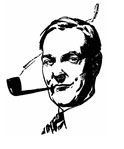
What We Can Learn from James Bond about Western Civ
SHAKEN NOT STIRRED
This year, for me, has been the year of trips, and the one most on my mind is the journey I took to Scotland (source of the back-country ethos that rules Cadiz, Ohio, my adopted hometown), where I spent ten days walking the West Highland Way with my sons — a project that afforded all kinds of adventures, the most “press ready” of which was being mistaken for the actor who played Hellboy in the eponymous 2004 and 2008 film versions of the Dark Horse comic-book series. A great honor! But the main adventures were learning terrain, and history keyed by that same terrain.
At Balmaha Harbor, after walking along the shore of Loch Lomond and glimpsing a chain of islands the placement of which indicates (exactly) the whereabouts of the geological fault line dividing Highlands from Lowlands, we learned that Scot was the Latin word for pirate and referred to folks who settled near the harbor in the fifth and sixth centuries after arriving from Ireland, thereby bringing Gaelic culture to the Scottish Highlands and eventually converting indigenous Picts. At Crianlarich, a crossroads where we left the River Falloch to follow a tributary that drains waters flowing southeast from mountains near Ben Nevis, we passed the ruins of an Augustinian monastery restored by Robert the Bruce in the 14th century. All that, before even getting to Kingshouse, an inn where British troops were garrisoned in 1742 after traveling on Cromwellian military roads to put down Jacobites who were trying to restore a Catholic monarch (James II’s grandson) to England’s throne.
“What is Scotland?” my younger son wanted to know early in the trip, after marveling at the medieval “sense” of the town/country interface visible along the West Highland Way, given the absence of suburbia. Me being me, I immediately told him that the way “in” was to read literature, specifically Thirty-Nine Steps author John Buchan’s little-known novel John Macnab (1925) and Robert Louis Stevenson’s Kidnapped (1886) — Buchan because of his high-resolution descriptions of trout fishing and cob-booted mountaineering, and Stevenson because of his sympathy for Jacobites and, of course, his de-facto map of the very same Highland route we ourselves were taking.
Kidnapped is set in 1751, just nine years after the Jacobites were defeated at Culloden, and you can learn a lot from Stevenson about their rebellion and the Enclosure Acts that precipitated it. Sure, Kidnapped is a boy’s adventure tale, but there is something deeper going on. It can, at times, be hard to see through the fog, if you will, of romanticized Gaelic culture that sits thick in Kidnapped and, indeed, almost all books by writers who came of age in the late 19th century, when Catholicism in the Highlands had been eradicated. But owing to his plot line, Stevenson ultimately enables the reader to grasp that the Jacobites weren’t just fighting to restore a Stuart monarch to the throne. In addition, and perhaps more importantly, they were fighting to reclaim the medieval commons, and the life sustained by access to that commons, so as to avoid what they intuited was coming — namely, the transformation of Scot farmers into tenant farmers (“crofters”) who lived behind a fence and paid rent to a landlord via secondary income derived from employment as laborers in a quarry (or on a seashore harvesting kelp). These crofters were then, not too many years later (after owners realized that profit could be better maximized if crofter houses themselves were bulldozed), expelled to America. Which, of course, is what happened between 1750 and 1815 during Highland Clearances, so called.
You May Also Enjoy
Ed. Note: Fr. Nouwen here continues the chronicle of the time he spent in Germany…
Hollywood knows there's a lucrative market for Christian movies -- as demonstrated by The Passion of the Christ, the modern-day gold standard for biblical screen portrayals -- and studios have big plans to cash in.
I traveled deep through the heart of Christian infrastructure — monasteries, art, books, and families — to see how it's crumbled and to report back to those who care.

